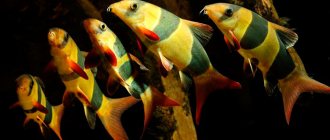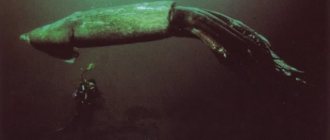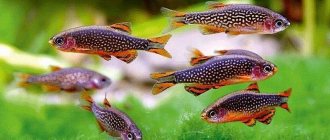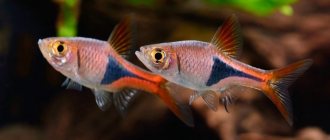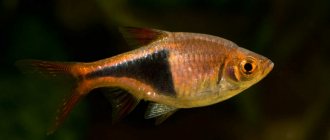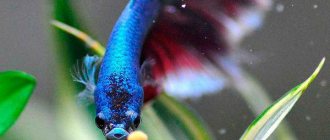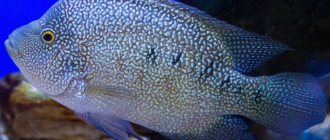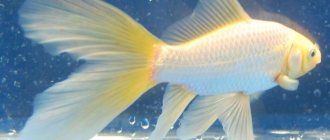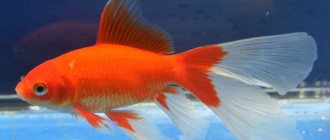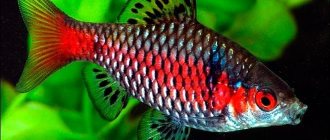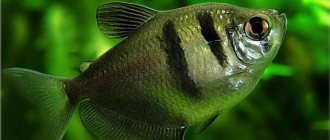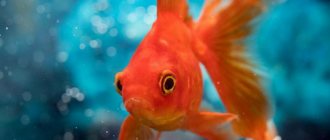Sea fish
Simplicity of content:
Latin name: Amphiprion percula (Amphiprion ocellaris)
Lifespan: 15 years
Maximum size: 8 cm.
Average cost: 1250 rub.
Amphiprion (clown fish) - from lat. Amphiprion percula. Amphiprion ocellaris may be found - this is a species of amphiprion identical in color and size, only living in natural conditions, that is, in ocean conditions.
A genus of marine fish from the Pomacentra family.
Clowns are the heroes of Disney cartoons.
Each of us is undoubtedly familiar with the amazingly beautiful fish from the cartoon “Finding Nemo”. Bright orange, small, it evokes tenderness and admiration not only in children, but also in adults, and as a pet is of interest to both amateurs and experienced aquarists. This article is intended for those who are interested in learning more about the hero of their favorite cartoon, as well as for those who have long dreamed of owning an aquarium fish with the self-explanatory name “clown”.
History of discovery
Amphiprions were first described in 1830 by naturalist Georges Cuvier, who saw them off the coast of Australia. Over the next decades, people repeatedly caught clown fish for the purpose of further keeping them in aquariums.
The main difficulty was to provide them with water, the parameters of which would be as close as possible to the natural habitat of amphiprions. Over time, this problem was solved and now clownfish have become frequent inhabitants of marine aquariums. But their real popularity came after the Pixar cartoon “Finding Nemo” was released on movie screens.
Interesting Facts
The amphiprion can attack its neighbors while feeding or when they approach its favorite places, for example, snags or coral
Aggression in clownfish may not be a distinctive feature of the species, but a real character trait. If the acquired individual has a belligerent attitude, then it is recommended to keep it only in pairs (there should be no other inhabitants in the aquarium).
Interesting Facts:
- Clown fish are born males, but their sex changes during life (initially the fish has well-developed organs of the male and underdeveloped organs of the female).
- They are capable of making various sounds (they click, crackle and create an imitation of grunting).
- Amphiprions are able to control the growth process of their body and stop it (for example, if there is a risk of expulsion from the pack due to their large size).
- Only large individuals have the right to mate in a school (small or young fish await their turn or the premature death of their larger relatives).
- The popularity of the clown fish increased rapidly after the release of the cartoon Finding Nemo.
When purchasing a clown fish, it is recommended that you inspect the fish carefully. A healthy amphiprion is brightly colored and has active behavior. The eyes should not be clouded, and any damage to the body is unacceptable. If you buy a clown fish that is caught from the wild and infected with disease, then all the inhabitants of the aquarium can die.
Habitat and lifestyle
In their natural environment, clownfish inhabit the waters of the Indian and Pacific oceans and are found in the coral reefs of Australia, off the coast of Japan and off the east coast of Africa.
Amphiprions inhabit the grottoes of coral reefs and huddle among underwater rocks. But most often they are found in dense thickets of sea anemones, which provide them with protection and food. During the evolution of clown fish, they learned to produce a special mucus that makes them immune to the poison of these coelenterates.
Before moving into a new “home,” amphiprions deliberately allow themselves to be stung so that the body begins to synthesize protection.
In the form of anemones, clownfish have found good protection from attacks from representatives of other species and, at the slightest danger, they hide among their tentacles. In turn, amphiprions also benefit coelenterates. They clean their tentacles of food residues, ventilate the water between them and lure other fish.
In nature, amphiprions live in schools, in which a clear hierarchy is built, and communicate using clicks, grunts and other sounds. Interestingly, they are all born males and can only become females under suitable conditions. For example, if the main female in a flock dies, one of the males changes sex.
Interesting! At the head of a school of amphiprions are always the two largest fish. The remaining members of the group always have more modest sizes and deliberately stop growing.
Nutrition
In their natural environment, Ocellaris eat the remains of their anemone prey. Thus, they cleanse its tentacles of dirt and decaying fibers. List of what the clown fish that lives in the ocean eats:
- animal organisms living at the bottom of the sea, including crustaceans and shrimp;
- algae;
- detritus;
- plankton.
Aquarium inhabitants are unpretentious in matters of nutrition - they feed on dry fish mixtures, which include tubifex, bloodworms, daphnia, gammarus, nettle, algae, soy, wheat and fish meal. Among frozen foods, clowns prefer shrimp, brine shrimp, and squid.
Feeding is done 2 times a day at the same time. During breeding, the frequency of food distribution increases up to 3 times. The fish should not be overfed - excess food may spoil in the water. After eating it, clowns can die.
Appearance
Clown fish are small in size and grow up to 7-9 cm. Although among them there are also larger specimens, the length of which reaches 11-15 cm. Amphiprions have an oval body, a convex head, oval fins and orange eyes.
The dorsal fin is formed by 14-17 rays and has an opening in the middle, creating the effect of having not one, but two fins.
The color of clown fish depends on the species and can be orange, white, brown, black or dark blue. The fins must have a dark edging.
Lifestyle
Amphiprions spend most of their time among the branches of sea anemones and try not to move away from their shelter
In their natural habitat, clownfish live in small schools under the leadership of the largest female. Amphiprions choose thickets of poisonous sea anemones as a unique place of residence. The settlement process is accompanied by a specific ritual. The fish touches the tentacles of the sea anemone with its body several times. Due to such actions, the surface of the clown fish is covered with protective mucus.
Features of the lifestyle of clown fish in the aquarium:
- the clown fish definitely needs shelter (in its absence, the fish may become overly anxious and become aggressive);
- if two females are placed in the aquarium, then one of them will definitely try to eliminate her rival;
- Aggression can be provoked by keeping an amphiprion alone in an aquarium or by a lack of food;
- The clown fish bravely guards its shelter, trying to bite, prick with the spines on its fin, or attack its offender in other ways (in the wild, amphiprions can even mistake divers for sources of danger).
Varieties
There are now more than 20 species of clownfish, many of which are artificially bred and suitable for keeping in an aquarium.
Clown Perkula
It lives in the Indian Ocean and is artificially bred in Florida. The fish grows no more than 12 cm long and is orange in color. There are three wide white and dividing black stripes on her body, and all fins are decorated with a dark border.
Anemone amphiprion ocellaris
A fairly large clown fish, up to 11 cm long, with a “frog” head and a dark edging around the eyes. Its color is a combination of black, white and orange, and the dark stripes on its body are narrower than those of other species.
Chocolate clown
The largest of all amphiprions grows up to 15 cm and is a tri-colored white-yellow-brown color. Young animals are painted in lighter shades, which become darker with age.
Red Clown
The length of representatives of this species does not exceed 13 cm, and the predominant color is red. There is a characteristic white stripe between the head and body, and the sides darken with age and become rich burgundy.
Interesting! Due to their characteristic red coloration, representatives of this species are often called “tomato” clowns.
Saddle Clown
Males grow up to 6-7 cm, females - 11-12 cm. The fish are black with two white stripes on the body and have yellow lower fins.
Skunk Clown
The fish grows no more than 12 cm and is colored pink or orange. There are no characteristic dividing stripes on her body, but there is a longitudinal white stripe on her back.
Clown Snowflake
A small amphiprion up to 8 cm long, it is colored red-orange with three very wide vertical white stripes.
Black clown
A relatively large amphiprion, the length of which reaches 13 cm. It is colored black and has three wide white stripes.
Maldivian clown
A brown-orange fish with dark fins and a light vertical stripe on the back of the head. It is a relatively large species and grows up to 11 cm.
Coral reef lovers
Clownfish live in large, stable populations in the shallow waters of the Red Sea and Indian Ocean, as well as in the western Pacific Ocean. They also prefer the warm waters of coral reefs. There are especially many of them off the coast of Southeast Asia and Australia. In winter, clownfish migrate to deep water where they can warm up.
They are not found only in the Atlantic, Caribbean or Mediterranean Seas.
Care and maintenance
Amphiprions are unpretentious schooling fish with a peaceful disposition. They are easy to care for and suitable for adding to your first aquarium. Much more difficulties for owners arise not with caring for the clowns themselves, but with maintaining the parameters of sea water and protecting and feeding sea anemones and corals.
Aquarium
When kept alone, clown fish become aggressive. Therefore, it is better to house them in pairs or small flocks. For two amphiprions, an aquarium of at least 100 liters is required; for a group of 5-6 individuals, a tank with a volume of 300 liters or more is required.
On a note. Before introducing clown fish into the aquarium, it is necessary to plant and adapt sea anemones. But we must remember that coelenterates require not only an additional increase in the volume of the tank, but also labor-intensive care.
Water
Clown fish need salty, clean water that meets the following parameters:
- temperature – 25-27 0C;
- hardness (carbonate) – 12-18;
- acidity – 8.1-8.4;
- density – 1.02-1.025.
In a medium-sized aquarium, change 10% of the water weekly. In large tanks, changes are made less frequently - once every 2 weeks, 25% of the water. It is important not to ignore sudden changes in fluid levels.
On a note. An aquarium with clown fish can be filled with settled tap water mixed with sea salt. The concentration of the latter should be up to 34.5 g/l.
Equipment
An aquarium with clown fish must have standard equipment. It must be equipped with a biological filter, aerator, thermometer and heater.
It is important that the filter does not create a strong flow of water.
It is better to place an aquarium with amphiprions so that the sun's rays do not fall on its glass. But due to the fact that both fish and sea anemones need good lighting, additional light sources should be installed in it. It is best to use LEDs with high performance and low heat dissipation for these purposes.
Ground and decorations
It is advisable to fill the bottom of an aquarium with clown fish with coral sand with a diameter of up to 5 mm. It is important that the thickness of its layer is at least 7 cm. Once every 1-2 weeks, the soil must be cleaned with a special siphon.
As decoration, it is advisable to use so-called “living” stones, which are pieces of natural coral reefs with algae and living microorganisms. If this is not possible, the aquarium can be decorated with grottoes, minks and other shelters.
Plants
In an aquarium with clown fish, algae species such as caulerpa, chaetomorpha and halimeda look good. And to recreate a natural habitat in a tank, you need to breed bubble, giant carpet, red-bodied, magnificent sea anemone or Mertens carpet anemone.
Compatibility
Clownfish are quite aggressive territorial fish. Therefore, its content must be properly organized from the point of view of compatibility of underwater neighbors.
Initially, it is worth introducing an already established male-female pair into the tank. But the aquarium will become more interesting if after a while new Amphiprions are added there. But you shouldn’t do this at once - it’s better to add one fish per week, then all members of the future flock will have time to get used to each other.
It is strictly necessary to follow the rule - one female for the entire tank. If there are two females, then the fights will continue until one dies. But in this struggle both can be destroyed. Then the largest male will take on the role of head of the clan and change sex.
It should always be remembered that the Clown Fish, being a protandric hermaphrodite, lives only in an anti-harem, where there is one female leader, one alpha male and many other smaller male individuals.
When introducing new family members, we must not forget about the rule - for every 2.5 cm of marine life there should be 9.5 liters of salt water. Overpopulation will cause a sharp surge in aggression even within the group.
You can diversify your marine aquarium with other inhabitants; these should be peaceful fish species that can get along well with Amphiprions:
- wrasses;
- surgeon fish;
- sea gobies;
- sea bass;
- angelfish;
- sergeant fish (abudefdufa);
- dog fish (pufferfish);
- invertebrates;
- corals;
- anemones (anemones).
It is unlikely that it will be possible to combine several varieties of clown fish in one tank; they will begin to fight for territory to the bitter end.
A good solution would be to add sea cleaners to the Amphiprions, who will never fight for the life zone or resources, but will happily eat waste, dead plants, and overgrown algae:
- sea snail;
- small crab
- Starfish.
You should not introduce into an aquarium with Clowns those fish that in nature are their enemies, for example, eels, lionfish, scorpion fish, and damsel fish.
And, of course, stinging sea anemones and clown fish coexist remarkably well, being symbiotes, in a sea reservoir. Anemones, lacking a mineral skeleton, and therefore the ability to move, cannot fully serve themselves. Amphiprions happily clean the sea anemone colony from “garbage”, eating food debris stuck in the “thickets”, and organize the flow of liquid among the tentacles, ventilating them. At the same time, they hide here with pleasure, sleep, lay eggs, from all points of view, a mutually beneficial neighborhood.
Feeding
Clownfish are omnivorous species. When kept at home, their diet should include:
- seaweed;
- worms;
- chopped shrimp;
- caviar;
- Artemia;
- fish fillet;
- spirulina;
- octopuses;
- squid.
You can also feed clownfish with dry saltwater fish food, such as Tetra Marine Flakes. It contains sea shrimp, high-quality fish oils, algae and other components necessary for the well-being of pets.
You need to feed the fish in small portions 2-3 times a day. You need to pour in exactly as much food as the clowns can eat in 3-5 minutes.
What does it eat?
In the wild, clownfish feed on algae, small crustaceans and other microscopic organisms. The main food for fry is plankton. Close interaction with sea anemones in natural conditions helps amphiprions provide themselves with food under any conditions. The fish actively eat the remains of her meals. This feature allows you not only to find food without extra effort, but also to carry out a kind of cleaning of your habitat. For sea anemones, the destruction of food debris by amphiprions is also beneficial.
Features of reproduction
When kept in captivity, clownfish are able to reproduce throughout the year.
Sex differences
Clowns have well-defined sexual dimorphism and females can be distinguished from males by their larger sizes.
Spawning
Amphiprion spawning occurs in the evening and lasts for two hours. The female lays up to 1,500 eggs, and the male guards them, reverently fanning his fins.
After 10 days, fry emerge from the eggs, capable of swimming independently and feeding on crushed adult food. And a characteristic pattern on their body appears at the end of the first week of life.
Offspring
Only the dominant couple produces offspring. All fry are hermaphrodites (possess both male and female reproductive cells) . But the female ones are in a “dormant state”, so all the babies that appear are males.
The breeding cycle of fish is associated with the phase of the moon and directly depends on it. If there are anemones in the reservoir, the female will lay eggs among the tentacles. If there is no symbiont, then a secluded place is chosen for laying .
Interesting! The entire flock takes care of the clutch, not just the parents.
The fry hatch in about 10 days. If the aquarium is not a species aquarium, it is better to place the fry in a separate tank and keep them there for some time.
Health and life expectancy
Under natural conditions, clown fish live for about 10 years. When kept in aquariums, their lifespan increases to 15-20 years. In general, amphiprions are characterized by good health, and all their diseases are associated with improper feeding or incorrectly selected parameters of the aquatic environment:
- Brooklynellosis. A sick fish becomes lethargic and becomes covered with white spots. For treatment, copper sulfate (1.5 mg/l of water) or malachite green (0.04 mg/l of water) is used.
- Cryptokaryonosis. It affects only the inhabitants of marine aquariums and its symptoms resemble ichthyophthyriosis. The disease is treated by reducing the salt concentration in the water and adding copper sulfate or formaldehyde.
- Oodiniosis. A sick fish develops a white rash, its fins stick together and its scales begin to peel off. For treatment, Bicillin, malachite green or copper sulfate are used.
Clown fish are colorful inhabitants of the underwater depths, with a peaceful disposition and interesting habits. They are easy to keep and breed, which makes them frequent residents of marine aquariums.
How to choose the right one when buying and what to pay attention to
When buying an amphitryon, choose one that was bred in captivity. They are better adapted to life in an artificial reservoir and are not infected with parasites and diseases.
Pay attention to the behavior of the fish. A healthy individual is active, curious, “talkative”, with a bright, uniform color, it has clear eyes without spots, smooth scales.
Amphitryons are bright, lively fish that will decorate your aquarium. Observing the life of a flock will be a fascinating leisure activity for lovers of exotic artificial reservoirs.
Male clownfish are devoted fathers
They not only prepare nests for eggs, but also protect future offspring and clean the nesting site. After 6-8 days the larvae hatch completely transparent. After spending about 10 days drifting, they settle on the bottom of the coral reef before beginning their search for the symbiotic anemone. During this time, they acquire the coloring characteristic of adults.
Thanks to the protection provided to the young by their host anemones, they have virtually no exposure to predators. The exception is when they have to run out for food; at this time they are hunted mainly by larger and more aggressive fish.
Clownfish form a symbiosis with sea anemones
Anemones, as clownfish are also called, earn this name because they form a symbiotic relationship with sea anemones. These creatures attach themselves to the ocean floor and use their tentacles to collect food. Sea anemones come in many varieties, but not all of them are clownfish-friendly. There are more than 1,000 species of anemone, and only ten of them can coexist with clownfish. Even so, clownfish prefer to form symbiotic relationships with only three species of anemone: Heteractis magnifica, Stichodactyla gigantia and Stichodactyla mertensii.
Photo: David Clode
Sea anemones secrete toxins from their tentacles, but clownfish avoid them by performing an intricate dance with the anemone. When the clownfish gently touches the anemone's tentacles, it acclimatizes, forming a layer of mucus that scientists believe gives it immunity to the anemone's deadly stings. Once established, the clownfish reaps the maximum benefit from this relationship: increased protection and safer access to food.
When a clownfish swims onto the reef, it attracts a larger individual and lures it back to the anemone. The anemone stings its prey and eats it, leaving the remains for the clownfish.
